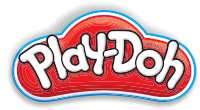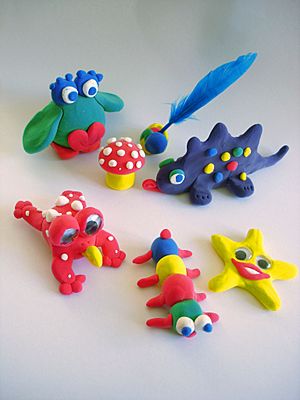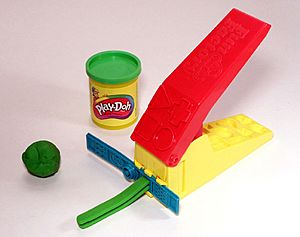Play-Doh facts for kids
 Logo used since 2015 
A can of green Play-Doh
|
|
| Type | Modelling clay |
|---|---|
| Inventor(s) | Kay Zufall Brian Joseph McVicker Bill Rhodenbaugh |
| Company | Kutol (1955) Rainbow Crafts (1956–1971) Kenner (1971–1991) Hasbro (1991–present) |
| Country | United States |
| Age range | 2+ |
| Availability | 1956–present |
| Slogan | Fun to play with, not to eat |
Play-Doh is a soft, colorful modeling compound. Kids use it to create all sorts of fun art projects. It was first made in Cincinnati, Ohio, United States. Surprisingly, it started as a cleaner for wallpaper in the 1930s!
In the mid-1950s, Play-Doh was changed and sold to schools. It was shown at a big education event in 1956. Soon, major department stores started selling it. Ads on popular children's TV shows in 1957 helped Play-Doh become very popular. Since then, many other Play-Doh toys, like the Fun Factory, have been created.
Contents
The Story of Play-Doh
How Play-Doh Began
Play-Doh was first a soft, putty-like substance. It was made by Noah McVicker at Kutol Products, a soap company. A grocery store chain, Kroger, asked for a product to clean coal soot from wallpaper. That's how the original cleaner was invented.
After World War II, people used less coal for heating. This meant less soot in homes. Also, new washable wallpapers became popular. So, the need for wallpaper cleaner went down a lot. Joe McVicker, Noah's nephew, joined Kutol to help the company.
Joe's sister-in-law, Kay Zufall, was a nursery school teacher. She saw an article about using the wallpaper putty for art projects. Her students loved it! She convinced Noah and Joe to make it as a toy for kids. Kay and her husband came up with the name "Play-Doh." Joe and Noah had wanted to call it "Rainbow Modeling Compound."
Launching Play-Doh as a Toy
Joe McVicker took Play-Doh to a convention for school supplies. A department store in Washington, DC, called Woodward & Lothrop, started selling it. In 1956, the McVickers created the Rainbow Crafts Company. This company was made just to produce and sell Play-Doh.
That same year, a three-pack of Play-Doh cans was introduced. After demonstrations in stores, Macy's in New York and Marshall Field's in Chicago also began selling it. In 1957, a chemist named Dr. Tien Liu improved Play-Doh. He lowered its salt content so models could dry without losing color. Play-Doh ads then appeared on famous children's TV shows. These included Captain Kangaroo, Ding Dong School, and Romper Room. By 1958, Play-Doh sales reached almost $3 million.
Play-Doh's Growth Over Time
In 1964, Play-Doh began to be sold in Britain, France, and Italy. By 1965, Rainbow Crafts received a special patent for Play-Doh. Also in 1965, the food company General Mills bought Rainbow Crafts. Later, in 1971, Rainbow Crafts and Kenner, another toy company, joined together.
In the 1980s, Play-Doh's cardboard cans were replaced with plastic ones. This was better because the old metal bottoms could rust. In 1991, Hasbro became the owner of Play-Doh. They placed it under their Playskool brand. Hasbro still makes Play-Doh today. In 1996, gold and silver colors were added to celebrate Play-Doh's 40th birthday.
Between 1955 and 2005, over two billion cans of Play-Doh were sold. In 2005, Play-Doh was sold in 75 countries. About 95 million cans were sold each year. In the United States, more than 6,000 stores carry Play-Doh.
Play-Doh was added to the National Toy Hall of Fame in 1998. In 2003, the Toy Industry Association put Play-Doh on its "Century of Toys List." This list names the 100 most memorable and creative toys of the 20th century.
In late 2014, the company offered to replace a tool from a Play-Doh playset. This was after some people complained about the tool's shape.
Play-Doh's Special Scent
To celebrate Play-Doh's 50th anniversary, a company called Demeter Fragrance Library made a special perfume. It smelled just like Play-Doh! It was for "highly-creative people" who wanted a fun scent that reminded them of childhood.
In 2018, Hasbro officially registered Play-Doh's unique smell. They described it as a "sweet, slightly musky, vanilla-like fragrance, with slight overtones of cherry, and the natural smell of a salted, wheat-based dough."
Play-Doh Mascots
In the mid-1950s, Play-Doh cans briefly showed pictures of children. Then came the Play-Doh Pixie, a small elf mascot. In 1960, Play-Doh Pete took over. He was a cartoon boy wearing a smock and a beret. By 1992, Pete's beret became blue, and his eyes looked more human. Later, in 2000, his beret was replaced with a baseball cap. Play-Doh Pete retired in 2003 after 42 years. Since 2012, the Doh-Dohs have been the mascots.
What's in Play-Doh?
Hasbro, the company that makes Play-Doh, says it's mostly a mix of water, salt, and flour. A United States patent from 2004 gives more details. It says Play-Doh has water, a starch-based binder, salt, lubricant, and other ingredients. These include a preservative to keep it fresh and colors.
A special oil-based additive makes Play-Doh feel smooth. Also, borax is added to stop mold from growing. Play-Doh contains wheat, so people with a wheat gluten allergy should be careful. It is not meant to be eaten.
Other Play-Doh Toys
In 1960, the Play-Doh Fun Factory was invented. This toy press pushes Play-Doh out in different shapes. The Play-Doh Fuzzy Pumper Barber & Beauty Shop (1977) and Mop Top Hair Shop (1986) let kids make "hair" for figurines and style it.
In 1995, a computer game called Play-Doh Creations was released. In 2003, the Play-Doh Creativity Table was sold. For Play-Doh's anniversary in 2007, new items came out. These included the Play-Doh Birthday Bucket and the Play-Doh Fifty Colors Pack. The Fuzzy Pumper Crazy Cuts was a new version of the old Barber Shop. In 2012, "Play-Doh Plus" was introduced. It's lighter, softer, and easier to mold than regular Play-Doh.
Play-Doh in Movies and TV
Movies
On April 2, 2015, 20th Century Fox announced plans for a Play-Doh movie. Hasbro Studios and Chernin Entertainment were going to produce it. Jason Micallef was writing the script, and Paul Feig was set to direct. However, this movie was later canceled.
On March 17, 2022, it was announced that a new animated Play-Doh movie is being developed. Entertainment One and Hasbro are working on it. Emily V. Gordon is writing, and Jon M. Chu is producing and might direct.
TV Series
A Play-Doh game show started streaming on Amazon Freevee. It first appeared as a holiday special on December 10, 2021. Then, a full series began on November 11, 2022. It is hosted by Sarah Hyland.
See also
 In Spanish: Play-Doh para niños
In Spanish: Play-Doh para niños
- Milliput
- Plasticine
- Plastilina
- Play-Doh, sculpture by Jeff Koons
- Sculpey




